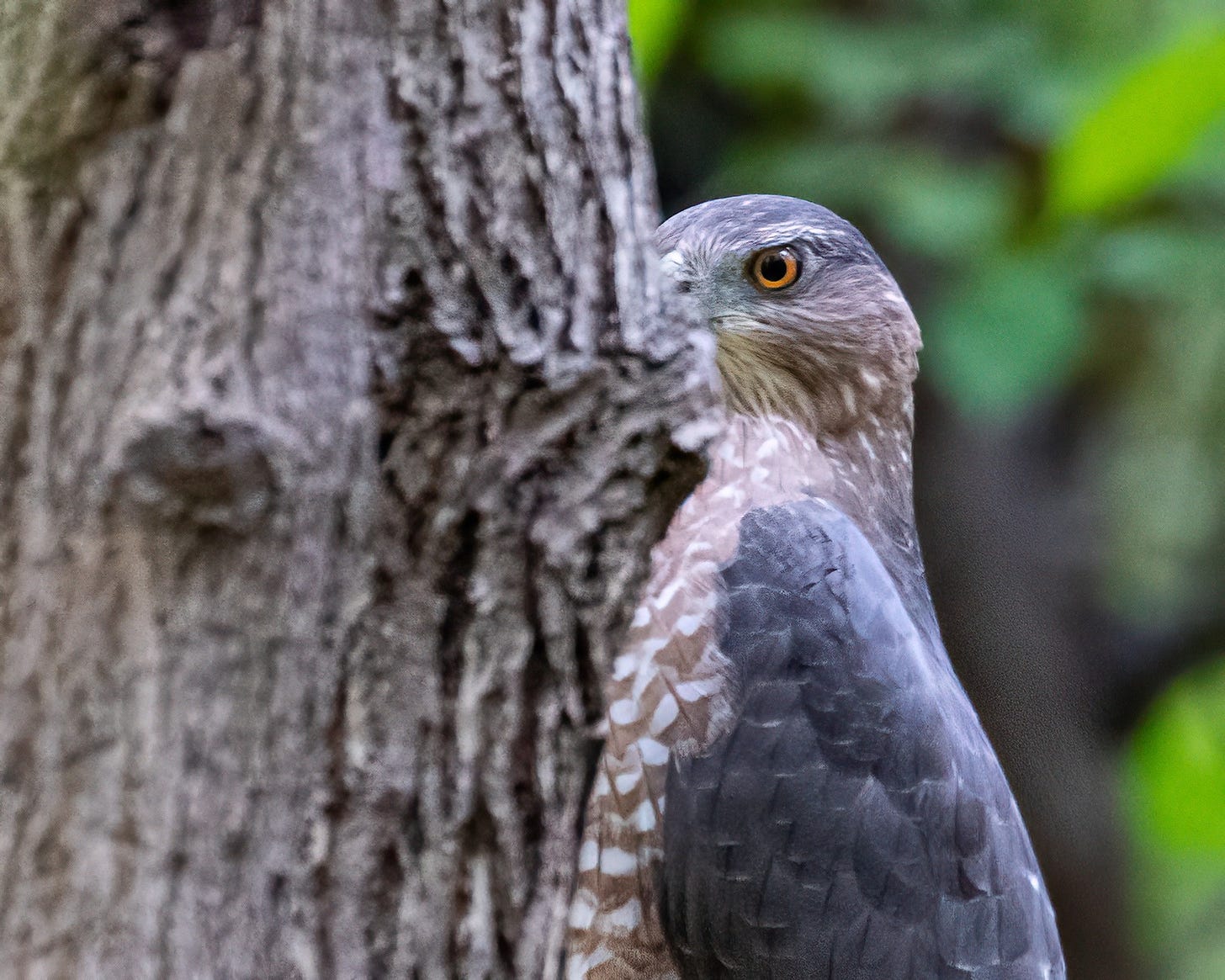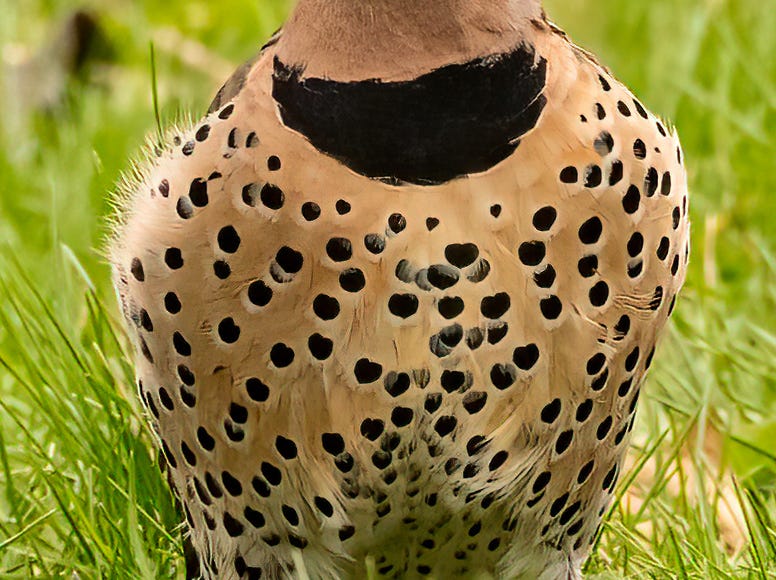It is a gorgeous time of year to be in the woods. Wild Turkey gobbles float on the wind. Once you are in tune with the turkeys' call, you can pick up distant, barely audible gobbles. It is a subtle cadence of spring that registers without conscious effort. The sensuous spring air is palpable on your skin. Life is rapidly unfurling from the soil. Bluebells, Spring Beauties, Toothwort, Violets, Hepatica, Jacob's Ladder, and many other wildflowers are in bloom. Cruising insects compete for nectar and pollen. The insects attract birds, including early spring migrants like Northern Flickers, whose numbers spike in our area this time of year as they pass through on their way north.
I like to stand still amidst flocks of Northern Flickers. Big groups of flickers forage in an open grassy field in my neighborhood park every April. Every once in a while, one of these wary birds will come quite close. They seem preoccupied with chasing ants as they hop and run in a random pattern while exploring the soil with their exceptional tongue, which extends 2 inches beyond the tip of their bill. They scan for predators every few seconds between bouts of probing the soil like a sewing machine.
The flicker I am watching is remarkably tame. She comes within 10 feet before hopping off to forage near the creek. As I am watching, I see a faint flash of shadow sweep across the grass.
I look up and see a Cooper's Hawk circling high over the field. He is flying in a tight circle. As I watch, the circles widen, and he starts to descend. The flicker does not notice.
The tiny speck of a hawk has now become a full silhouette as he loses altitude. He passes behind the trees over the creek and disappears from sight. The flicker is still busy probing for ants.
I scan the sky above the trees and see the Cooper's Hawk in a full stoop, wings folded back, dropping fast. He slices through a gap in the tree canopy and slams into the flicker. I hear the flicker make one last call as the air is forced out of her lungs with the impact.
The hawk mantles over the flicker. I see a few flashes of yellow, and then all is still. The hawk stares across the field with intense red eyes. He does not move for a few minutes, and then he suddenly rises in labored flight as he carries the flicker into the canopy of a sugar maple tree.
I am awash with adrenaline. I turn to look at other people nearby, ready to exclaim, "That was amazing!" only to realize that no one else noticed. The incredible life-and-death drama was lost on them. The power, grace, beauty, and sadness on display are the purview of birdwatchers.
I walk over to the spot where the flicker was killed. The only sign is a single, bright, yellow tail feather. Flickers seem to be ideal prey for Cooper's Hawks. They spend time in the open in short grass with their heads down, probing in the soil. Flickers appear to sense their vulnerability, and they often forage in groups where they scan constantly for predators, but the hawks are stealthy and fast.
It is sad to watch the brilliant light of a flicker fade away. A flickering candle has gone out, and the eyes of the Cooper's Hawk burn brighter. On the whole, flickers are doing well. There are an estimated 11 million flickers in North America. They are widespread and adaptable birds that shape the landscape in ways we will never fully comprehend. They excavate cavities in dead and dying trees that many other species use as roosts and nests. They are also the primary predator of ants in North America.
The females are considered indefinite layers, and they put their energy into producing large clutches of eggs. Researchers have removed eggs from a flicker nest and documented a female flicker laying 71 replacement eggs. That is a lot of energy and a lot of life force.
When I get home, I watch flickers foraging in my backyard. We have had four flickers foraging in our yard for at least five hours. We have one three-foot diameter ant mound in our yard, but they never probe in the mound itself. They have learned not to disturb the ant colony. They focus on catching single ants that are coming and going so they can avoid being attacked. They also are adept at catching insect larvae in the soil. Having flickers forage in your yard is a badge of honor and a sign that you are fostering life in the soil.
I want to put up a sign in our front yard to share wildlife statistics for the year with our neighborhood residents.
We have 18 birdhouses,
Our yard has produced 26 hours of flicker foraging,
4 broods of House Wrens,
2 broods of Chickadees,
3 broods of Robins,
2 broods of Cardinals,
5 broods of House Sparrows,
1 brood of Carolina Wrens,
2 broods of Gray Catbirds,
and untold numbers of butterflies and other insects.
I think these make interesting conversation topics. The next time I get pulled into discussing current events, I will keep redirecting back to wildlife. “Did you know that the divorce rate among flickers is four percent? Apparently, they know something about marital harmony that we do not. Maybe it has to do with the males providing more parental care than the females. They also love to dance.”
Northern Flickers start fencing duels during spring migration as part of their territory establishment and pair bonding. Two birds of the same sex face off with their bills pointed up in the air. These wicka bouts ensue, with each bird swinging its head back and forth and up and down. They appear to be tracing figure eights in the air. This is accompanied by in-rhythm wicka calls from both dancers. This performance often attracts other flickers. When a bird of the opposite sex shows up, the dance intensifies, and all birds are compelled to dance. Flickas gotta wicka dance.
In the spring, go to the park and climb the terrace,
But I alone am drifting, not knowing where I am.
Like a newborn babe, before it learns to smile,
I am alone without a place to go.
Everyone else is busy,
But I alone am aimless and without desire.
I am different.
I am nourished by the great mother.
Lao Tzu, Tao Te Ching













An excellent post Bill. I believe , one of your best.
The photography.
The magic and new life of spring, in your own backyard, has filled your senses . In the very best way.
The single yellow feather.
The true path nature must take.
You honor her with your words.
“The power, grace, beauty, and sadness on display are the purview of birdwatchers.”
Thank you, Mr. Davison. Magnificent.